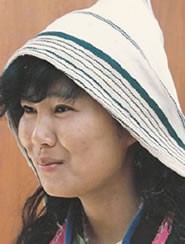Jinuo in China

Photo Source:
Copyrighted © 2026
Operation China, Asia Harvest All rights reserved. Used with permission |
Send Joshua Project a map of this people group.
|
| People Name: | Jinuo |
| Country: | China |
| 10/40 Window: | Yes |
| Population: | 23,000 |
| World Population: | 23,000 |
| Primary Language: | Jinuo, Youle |
| Primary Religion: | Ethnic Religions |
| Christian Adherents: | 3.00 % |
| Evangelicals: | 0.52 % |
| Scripture: | Translation Needed |
| Ministry Resources: | No |
| Jesus Film: | No |
| Audio Recordings: | Yes |
| People Cluster: | Tibeto-Burman, other |
| Affinity Bloc: | Tibetan-Himalayan Peoples |
| Progress Level: |
|
Introduction / History
One link between the Jinuo and the Bible is the Great Flood. Every Lunar New Year in February, the Jinuo celebrate by dancing around a large ox-hide drum. For centuries the Jinuo have orally passed on from generation to generation a story about how the human race perished in a huge flood. Their ancestors were able to survive because they found shelter in a huge drum. Being directed by a god, they received ten calabash seeds that sprouted and produced all the peoples in the world.
The Jinuo gained recognition as an official minority in 1979, becoming the 55th and most recent group to gain status in China. Previously, the Jino were considered part of the Dai nationality. The name Jinuo comes from the words ji "uncle" and nuo "descendants", therefore meaning "the descendants of the uncle."
The Jinuo language is part of the Tibeto-Burman branch and is similar to Sanda and Ake - two related groups also in Xishuangbanna. There are two mutually unintelligible Jinuo languages: Jinuo proper and Buyuan Jinuo, which the second listed language. The differences are mainly in vocabulary. All Jinuo are able to speak their mother language. Many can also speak Tai Lu, Chinese, or Akha, depending on their location. The Jinuo do not have a written script. In the past, they tied strings around their wrists or carved notches in wood or bamboo to help remind them of their tasks needed to complete. In the event of an emergency, the Jinuo sent a feather or a piece of charcoal to their neighbors as a sign they needed help.
What Are Their Lives Like?
Jinuo women are easily identified by their large triangular hoods. When a Jinuo dies, they are buried in a hollowed-out tree and small huts are constructed over the graves.
What Are Their Beliefs?
The Jinuo group members have their own unique religion. Around AD 200, Kong Ming - also known as Chu-ko-Liang or Zhu Geliang - helped establish the Minor Han Dynasty. The Jinuo served in Kong Ming's military campaign into southwest China, but many were left behind. Kong Ming remains a favorite war hero of the Chinese. In 1724 he was included in a kind of Chinese Hall of Fame when his tablet was admitted to the Confucian Temple. Kong Ming is the main god among many worshiped by the polytheistic Jinuo.
Until recently there had never been a known Jinuo church or believer. In 1994 Tai Lu and Han Chinese believers from Jinghong and Mengla focused on the Jinuo. As a result, 31 Jinuo house churches were established in a short period of time, containing more than 300 believers. The young church met strong persecution. The local authorities handed out aid to all Jino except the Christians after a severe hailstorm destroyed their crops in 1997. Churches have been ordered to close by village leaders who are afraid of the new religion.
What Are Their Needs?
Without the guidance of Christ, these people will be lost in this life and the life to come.
Prayer Points
Pray that the Jinuo people will have a spiritual hunger that will open their hearts to the King of kings.
Pray for the spiritual blindness and bondage to the evil one to be removed so they can understand and respond to Christ.
Pray for the Lord to provide for their physical and spiritual needs as a testimony of his power and love.
Pray for a movement of Christ to increase God's Kingdom expansion among the Jinuo people group.